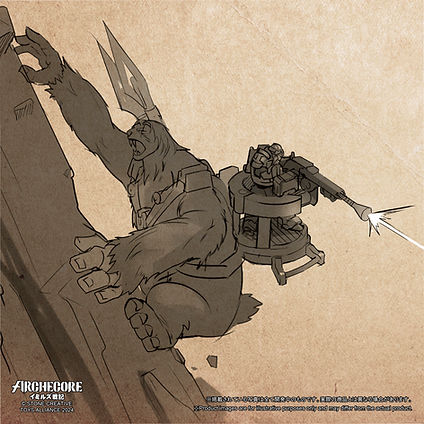top of page


MOBILE SUIT
Military-Grade Megalith Sloth

Affiliated Legion
MITHRIL HAWK

Biological Setting
The civilian version of the 'Imitation Divine Weapon,' practical applications of Embed Beasts in combat.
Power System:
Firefly . Forced Controller.
Armor Material:
Biological Fur . Equipment Harness.
With the mass production of the Vyk's mythical giant "Imitation Divine Soldiers," Castan became increasingly aware of their lack of large units for breakthroughs on the frontlines. While supporting the Sand Lizard Tribe with military aid, Castan witnessed how the Sand Lizard people effectively used Embed Beasts as assault vehicles. This led the Castan to also explore Embed Beasts as emergency large-scale units. At this time, a staff knight of the Silver Eagles, "Lead Attacker" Lendesta, began contemplating the situation. Observing the "Swift Rock Sloth" in mountainous areas, a creature possessing strength and climbing abilities, Lendesta envisioned the potential of these beings for the Castan forces.


The Swift Rock Sloth is not a native species; its prototype is the giant sloth, a creature known for its slow and sluggish nature. However, under the influence of the abundant blue crystal energy on the Osga Continent, many biological populations were subjected to the effects of mutagenic energy. These creatures evolved an organ called the firefly and underwent a biological phenomenon known as 'Embedding,' resulting in a fusion of distinct features. This gave rise to the collectively termed 'Embed Beasts,' an aberrant species. Among them, the giant sloth fused with simian characteristics, deviating from its original form and metamorphosing into a new species capable of standing upright and agile climbing, known as the 'Swift Rock Sloth.
The Castan people discovered that these rock sloths, much like primates, could manipulate tools and easily climb over challenging terrains, including human defense fortifications. However, lacking the Sand Lizard skills to domesticate Embed Beasts, the Castan people resorted to invasive methods. They inserted controllers into the firefly organs to operate the 'Swift Rock Sloths.' This harsh procedure significantly heightened the beastly nature of the Swift Rock Sloths.
With such a military organism, Lendesta began conceptualizing patterns for use. Apart from equipping the sloths with weapons, craftsmen were also tasked with manufacturing equipment vests for carrying supplies. In addition to carrying the massive Soul Spear for heavy units, these vests were augmented with machine gun mounts to allow the rider to provide synchronized firepower support. The backpack concealed a Y-energy canister (Y-thermos), supplying energy to the firefly organ through tubing, enhancing the explosive power of the rock sloths.


Knights, citing a violation of chivalry, refused to ride Embed Rock Sloths into battle. Recognizing the swift nature of the Rock Sloths, particularly effective in overcoming obstacles, Lendesta began considering the possibility of having common soldiers as riders. Acknowledging that the Swift Rock Sloths were best suited for assaulting challenging terrains, and to enhance the element of surprise, pairing them with soldiers wearing mythical armor was deemed optimal. In the event traditional heavy knights were unwilling to ride, without hesitation, mythical armor tailored for assault needs was assigned to the soldiers.
The traditional mining armor underwent a redesign, reducing the coverage of the armor while reinforcing frontal protection. This not only lowered costs but also increased walking sprint force and enhanced frontal protection for assault purposes. Abandoning the need for skilled knights to wield close combat high-energy weapons, the soldiers were equipped with SP40 Soul Pressure Assault Rifles and throwing hammer-type Soul Pressure grenades. This further reduced costs while providing ordinary soldiers with preemptive firepower and impact.
bottom of page
